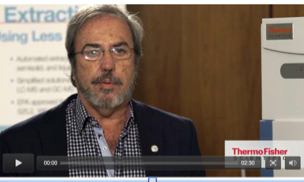Listen to a 3-minute interview with industry expert Professor Amadeo R Fernandez-Alba from the EURL Reference Laboratory as he discusses trends in pesticide analysis. View here.


Listen to a 3-minute interview with industry expert Professor Amadeo R Fernandez-Alba from the EURL Reference Laboratory as he discusses trends in pesticide analysis. View here.

Some polar ionic pesticides and their associated metabolites are not “amenable” to common multi residue methods, such as QuEChERS. These compounds need alternative extraction conditions for improved recovery and/or alternative separation conditions for improved retention and/or peak shape. Currently the polar pesticides tend to be treated as a series of selective single residue methods adding significant cost to the analysis and therefore, are often excluded from pesticide monitoring programs. At Fera we have coupled the QuPPe generic extraction conditions with determination by suppressed ion chromatography tandem quadrupole mass spectrometry. This presentation will describe our experiences and challenge faced in implementing this method, presenting validation data in a cereals matrix. View the presentation here.

Evaluation of Q Exactive LC-MS for Pesticide Residues in Fruits and Vegetables – Plenary Lecture: Abstract: The Thermo Scientific™ Q Exactive™ LC-MS has been evaluated for detection, identification and quantitation of pesticide residues included in the European Union Monitoring Program. Pesticides were analyzed in four matrices representing wide range of difficulty (tomato, pepper, orange and green tea). Read more and watch the lecture here.


Moving forward, if food manufacturers, suppliers and distributors want to be ahead of the game, they’ll need to have the ability to view their product throughout the supply chain. During a discussion with Food Safety Tech, Trish Meek, director of product strategy at Thermo Fisher Scientific, explains the importance of product traceability in the food chain, from both a consumer and food producer’s perspective.
Food Safety Tech: In your recent article about Integrated Informatics, you cite it as an ideal solution to modernizing a highly distributed food chain. What are the challenges you see companies facing in managing their global supply chain?
Trish Meek: We’ve seen the issues related to intentional adulteration documented throughout the media, and they extend to traceability. For example, what Tesco experienced during the horsemeat scandal wasn’t necessarily intentional adulteration, but rather a matter of not understanding the supply chain. Horsemeat was introduced in France as legitimate meat and then it ended up in the UK. In this case, you have a lack of traceability and thus a lack of understanding of what has happened to your product in its lifecycle.

In this complex world of suppliers, distributors and food producers, having the ability to pull in analytical data and manage it regardless of the source (whether it’s from the initial ingredient supplier or the final manufacturer) is a critical piece in understanding the overall lifecycle picture. An integrated informatics solution provides a single source of truth for that information: From the technician operating the lab process to the lab manager who is overseeing to the integration into the enterprise-level system. It provides a complete view on everything that has happened to your data, while also enabling the management of regional specifications.
FST: What are the biggest concerns in the area of food chain security?
Meek: Traceability is key, and the common denominator is food chain security: Ensuring that you’re providing security and with an understanding of everything that happened to your product, which leads to quality assurance and brand security.
FST: What are the concerns related to food chain security?
Meek: There are a few concerns:
|
Using an Integrated Informatics Platform Trish Meek: Through an integrated informatics platform, users can manage the entire lab process and integrate it into the enterprise system. Having the ability to incorporate the lab data is critical to ensuring product safety, quality and traceability throughout the entire supply chain. Because the solution encompasses lab processes and required lab functionalities, it enables efficiency both in the laboratory as well as across the entire operation. The solution provides an opportunity not just to the top-tier food producers but also the regionally based middle-tier companies that want to set themselves up for future growth. The reality of the regulations today is that you must look towards the future. Twenty years ago, we weren’t including information about what nuts were present in the labeling. Now there’s consumer awareness and a change in labeling. And five years from now, there could be a different allergy that needs to be documented in the labeling. Integrated informatics gives you the business agility to take on that next step of analysis and adapt to the marketplace. |

In a Q&A with Food Safety Tech, Aaron Kettle, sample preparation product manager at Thermo Fisher Scientific discusses the advantages of using accelerated solvent extraction for pesticide residue analysis and its applications in the food industry.
Food Safety Tech: What are the benefits of using accelerated solvent extraction versus other more time-consuming sample prep methods?
Aaron Kettle: It can save a considerable amount of time over techniques such as Soxhlet and sonication that are used in this industry. In addition, the amount of solvent you’re using is cut down by at least five fold using this technique. The other advantage over some of the other techniques is that it allows walk-away capability, so your samples can be loaded and you can run your methods overnight. It’s pretty much just load the buttons and walk away, and by the time you come in the next day, everything is ready for analysis.
FST: Discuss this method in the context of today’s environment as it relates to importance of detecting the presence of pesticide residue and harmful pollutants.
Kettle: It’s certainly beneficial. It doesn’t have matrix limitations so you can use it for a lot of different sample types: High-fat content samples, such as avocados, dry samples like bread and grain, and high-water content samples like tomatoes.
FST: Are there specific food applications that benefit from accelerated solvent extraction, including those in which the method is underutilized?
Kettle: I don’t think the technique has a lot of use right now for high-water content samples, such as pesticide residue extraction for tomatoes, berries, etc. That primarily has to do with the fact that historically it hasn’t worked well with these kinds of samples. However, we’ve recently released a moisture-absorbing polymer that acts to remove residual water without interfering with the extraction and recovery of the analytes. That has allowed the accelerated solvent extraction to work with these sample types. That’s an area where’s it’s being underutilized right now, primarily because it is a relatively new product release for us. It’s an area where we’d like to see adoption continue to increase.
FST: What is unique about the polymer being used in this detection method?
Kettle: It’s a proprietary mixture that will remove water content up to 85%. There are no major specifics; it will work with any kind of matrix that has water in it—fruits, berries, etc.
FST: What are the top advantages of the technology?
Kettle: The ability to remove residual water is important. It happens prior to the sample being loaded in the extraction cell. There is no limitation with high-water content samples. It mixes well with the dispersing agent, so not only can you add a dispersing agent to help solvent flow through the matrix better, you can also add the polymer to help it through water. It helps expand the capability of the accelerated solvent extraction in what it can do in the food market for pesticide extraction.
FST: What are your expections of this technology within this niche moving forward?
Kettle: We would like to see it expand and have greater awareness and acceptance for the accelerated solvent extraction in this particular area. Right now, folks are using a manual technique for these types of samples, so we’re hoping these customers will accept the walk-away automation and the flexibility that this technique will provide.